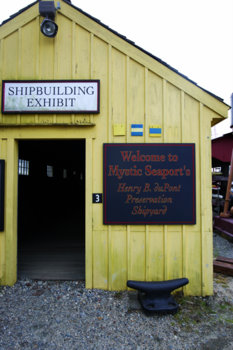 The 92-foot keel assembly from the whaleship Thames is set up on blocks in a shed within the Preservation Shipyard. The keel is the “backbone” and the starting point for the construction of a ship and so, displayed along the entire length of the keel, is an exhibit on the process of shipbuilding that takes visitors from the laying of the keel to her launching.
The 92-foot keel assembly from the whaleship Thames is set up on blocks in a shed within the Preservation Shipyard. The keel is the “backbone” and the starting point for the construction of a ship and so, displayed along the entire length of the keel, is an exhibit on the process of shipbuilding that takes visitors from the laying of the keel to her launching.
Built in 1818 on the Connecticut River at Essex, the Thames sailed from Sag Harbor for most of her career. She ended her days scuttled as a breakwater in Sag Harbor after being condemned in 1838. Fair Helen, a somewhat smaller whaler, suffered the same fate, and about 1930 both were dynamited in order to recover quantities of copper with which they were sheathed and fastened. Embedded as they were in the mud, the lowest portions of these vessels escaped with little damage.
Their timbers were rediscovered in 1968 during construction of a marina, a few having been encountered earlier (in 1946 or 1947) when a railway was built on the same site. Fifty-five individual timbers, 51 of which were from the Thames, were pulled out in 1968 by Saltair Industries and given to the Museum in December 1971. Verifying that these timbers were in fact from Thames and Fair Helen was an undertaking in itself. The research, together with measurements and comparisons of the timbers, has enabled us not only to confirm their identity as to a particular vessel but also to ascertain their function within the vessel.
Research and documentation is essential to the work of preservation and restoration of the Museum’s exhibit vessels. Unique to Mystic Seaport also is the awareness that to preserve our vessels we need also to preserve those skills of the trade of wooden shipbuilding portrayed in this exhibit.


